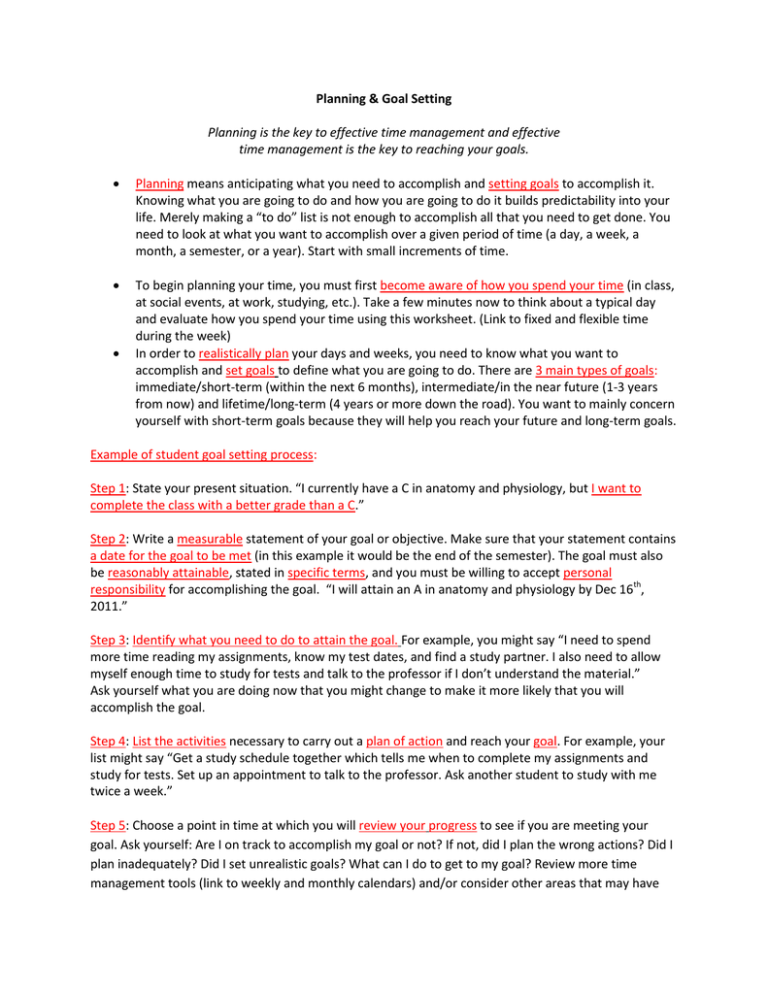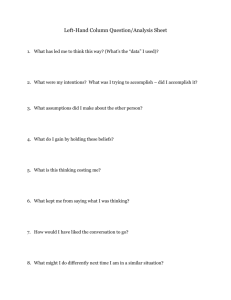Planning & Goal Setting
advertisement

Planning & Goal Setting Planning is the key to effective time management and effective time management is the key to reaching your goals. • Planning means anticipating what you need to accomplish and setting goals to accomplish it. Knowing what you are going to do and how you are going to do it builds predictability into your life. Merely making a “to do” list is not enough to accomplish all that you need to get done. You need to look at what you want to accomplish over a given period of time (a day, a week, a month, a semester, or a year). Start with small increments of time. • To begin planning your time, you must first become aware of how you spend your time (in class, at social events, at work, studying, etc.). Take a few minutes now to think about a typical day and evaluate how you spend your time using this worksheet. (Link to fixed and flexible time during the week) In order to realistically plan your days and weeks, you need to know what you want to accomplish and set goals to define what you are going to do. There are 3 main types of goals: immediate/short-term (within the next 6 months), intermediate/in the near future (1-3 years from now) and lifetime/long-term (4 years or more down the road). You want to mainly concern yourself with short-term goals because they will help you reach your future and long-term goals. • Example of student goal setting process: Step 1: State your present situation. “I currently have a C in anatomy and physiology, but I want to complete the class with a better grade than a C.” Step 2: Write a measurable statement of your goal or objective. Make sure that your statement contains a date for the goal to be met (in this example it would be the end of the semester). The goal must also be reasonably attainable, stated in specific terms, and you must be willing to accept personal responsibility for accomplishing the goal. “I will attain an A in anatomy and physiology by Dec 16th, 2011.” Step 3: Identify what you need to do to attain the goal. For example, you might say “I need to spend more time reading my assignments, know my test dates, and find a study partner. I also need to allow myself enough time to study for tests and talk to the professor if I don’t understand the material.” Ask yourself what you are doing now that you might change to make it more likely that you will accomplish the goal. Step 4: List the activities necessary to carry out a plan of action and reach your goal. For example, your list might say “Get a study schedule together which tells me when to complete my assignments and study for tests. Set up an appointment to talk to the professor. Ask another student to study with me twice a week.” Step 5: Choose a point in time at which you will review your progress to see if you are meeting your goal. Ask yourself: Are I on track to accomplish my goal or not? If not, did I plan the wrong actions? Did I plan inadequately? Did I set unrealistic goals? What can I do to get to my goal? Review more time management tools (link to weekly and monthly calendars) and/or consider other areas that may have caused you to not meet your goals (link to all documents on motivation and personal responsibility), then start back at Step 1. Author: Shirley “Mandy” Sexton, Ph.D.
